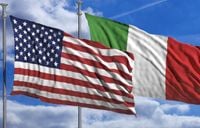As the clock ticks down to April 2, 2025, the Veneto region of Italy stands at a critical juncture, with its exports to the United States valued at an impressive 7.3 billion euros—a staggering 30% increase since 2019. Yet, looming on the horizon are the potential tariffs imposed by the Trump administration, which could drastically alter this favorable trade landscape.
Vicenza, the star performer in this export surge, accounts for over a third of the total, with exports exceeding 2.2 billion euros. However, President of Veneto, Luca Zaia, is not celebrating just yet. He has voiced serious concerns about the repercussions of the impending tariffs, stating, "We are on the eve of a crucial day for the world economy. If universal tariffs of 20% on all trade with the U.S. are confirmed, tomorrow could mark not the 'day of liberation' promised by Trump, but rather a new black swan event, following the pandemic and the wars in Ukraine and Israel. It will be a day that will remain in the economic and geopolitical history of the world."
The growth trend in Veneto's exports has been consistent since 2019, reaching 29.8% in 2024, translating to a total of 7,272,985,300 euros. This growth is primarily driven by mechanical production, which contributes nearly 1.65 billion euros, and medical instruments and supplies, predominantly in the eyewear sector, which accounts for around 1.2 billion euros. The agri-food sector also plays a significant role, contributing almost 1 billion euros (927,050,324 euros) and witnessing the largest economic growth compared to 2023 at +15.9%. Unfortunately, the fashion sector has not fared as well, seeing a decline from 696 million to nearly 549 million euros.
Despite the overall increase, Veneto's exports to the U.S. experienced a slight contraction of 3.8% in 2024, largely due to challenges in the fashion and metallurgy sectors. In terms of provincial contributions, Vicenza leads with 30.4% of the regional value, although it has seen a 4.7% decrease compared to 2022, which was a record year. Other provinces like Treviso and Verona have shown growth, with Treviso increasing by 5.1% to 1,345,596,217 euros and Verona by 6.2%, aided by wine exports.
Zaia emphasizes the importance of safeguarding the Veneto companies that have invested heavily in the U.S. market. He states, "One in five bottles of Veneto wine sold abroad is purchased by U.S. commercial partners. Given the numbers and the context, it’s easy to understand the disastrous effect that a 20% tariff could have on the turnover of Veneto companies. We must not settle for the boom of past years. We need to protect those companies that have invested resources, personnel, and ideas in exporting to the U.S., creating a revenue stream that benefits the entire country." He calls for urgent diplomatic action to address these potential tariffs, urging that "diplomacies should speak, not tariffs, and a way should be found to realign a global market that could suffer from protectionist policies. There is no more time; we must act urgently."
Meanwhile, the broader implications of potential tariffs extend beyond Veneto. In 2023, Italian exports to the U.S. reached a total of 66 billion euros, with at least 16 billion euros directly exposed to the risks of a trade war. The automotive sector alone exports over 5.4 billion euros to the U.S., while fashion exports are valued at 9.1 billion euros. The food sector, a cornerstone of Italian culture, sold nearly 6 billion euros in products to the U.S. last year, including iconic items like parmesan cheese and olive oil. A significant increase in tariffs could severely disrupt these markets, pushing American retailers to seek alternatives.
Italian fine mechanics, which includes exports of nearly 10 billion euros, is another sector that could feel the strain of increased tariffs. Companies specializing in industrial robots and compressors, particularly in regions like Bologna and Vicenza, are already beginning to see orders slip as Asian competitors gain ground. Additionally, the pharmaceutical sector, which exported over 8 billion euros to the U.S., could become less competitive if tariffs target active ingredients, pushing U.S. healthcare systems to look elsewhere.
Confindustria, the Italian industrial association, warns that every billion euros in lost exports could translate to 15,000 jobs at risk. The Italian National Institute of Statistics (Istat) estimates that a trade war could potentially reduce Italy's GDP by up to 5 billion euros. As Europe prepares its own list of products to target in retaliation, the situation remains precarious. The cycle of retaliatory tariffs only exacerbates the challenges faced by Italian producers.
In this complex landscape, the Italian government is caught in a difficult position—too large to be ignored, yet too small to impose its will effectively. The fate of countless Italian businesses hangs in the balance as negotiations unfold in Brussels and Washington. The consequences of this trade dispute will not only affect the bottom line of corporations but also the livelihoods of workers across Italy.
As the date of potential tariffs approaches, the stakes couldn't be higher for Italy's manufacturing and export sectors. The looming question remains: will diplomacy prevail, or will tariffs usher in a new era of economic uncertainty for Italian businesses?






